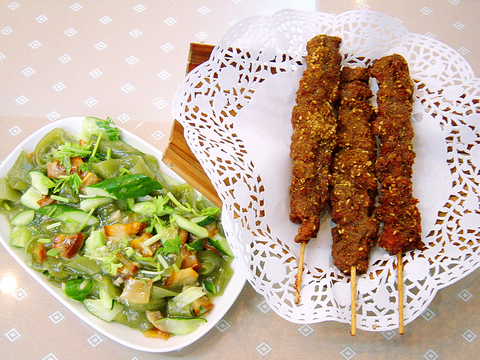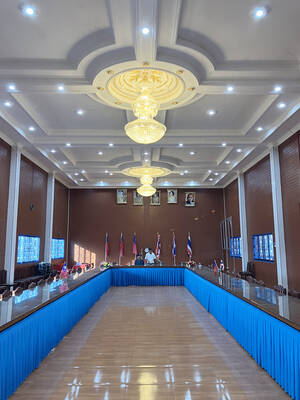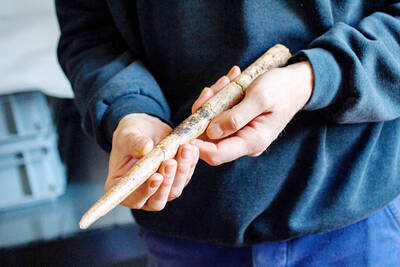A hidden gem in the maze of restaurants across from Sun Yat-sen Memorial Hall (國父紀念館), King of Dumpling Haerbin Restaurant is a well-kept secret among gourmets searching for a real taste of northeastern Chinese cuisine.
Walking into the modest joint with seating for about 20 patrons, first-time customers are likely to be surprised by the thick menu featuring 394 dishes and over 30 kinds of dumplings. Depending on the seasonal ingredients available, the joint offers 50 dishes and 12 kinds of dumplings a day to ease the confusion.
“Noodles and dumplings are our staple food, while salad is the essential part of our diet,” said proprietor Chung Tung-hai (鍾統海), a licensed and experienced chef from Harbin, capital of Heilongjiang Province, China.

PHOTO: HO YI, TAIPEI TIMES
The importance of salad in the cuisine is apparent by the over 160 varieties on the menu that include the representative chiang yu (熗油) salads. The joint's self-made specialty, chiang yu is a type of seasoning oil mixed with herbs. The crispy potato slice (熗土豆絲) is a recommended dish to savor the scent of chiang yu, while pig ear cucumber noodle (豬耳黃瓜拉皮) is a savory mixture of marinated gelatin and cold noodle made of green tea and potato.
As for the exotic dumpling variations, popular choices include pickled Chinese cabbage, white radish beef, onion lamb and sailfish mixed with basil and squid. The dumpling wrapper is made according to Chung's secret formula, who stays up till 2am every night making fresh dumplings along with his wife and partner Tsai Fu-mei (蔡富美).
Their popular side dishes are smoked chicken wing (NT$30) and lamb brochette (NT$40). The tasty chicken wing is blessed with the smoked flavor of tea and sugar, while the brochette is first fried then grilled to make the meat crispy on the outside and tender and juicy on the inside.
Crystal sugar-coated sweet potato (拔絲地瓜) is a must-try dessert famed for its strenuous preparation process. The harmonious union of the crisp, cold sugar coating with a tang of sesame and the warm soft starch brings pleasure to the stomach.
Even though Chung is usually exhausted by the end of the day as the culinary art in the region requires meticulous preparation and complicated cooking steps, he still insists on making all the ingredients from scratch.

Taiwan Power Co (Taipower, 台電) and the New Taipei City Government in May last year agreed to allow the activation of a spent fuel storage facility for the Jinshan Nuclear Power Plant in Shihmen District (石門). The deal ended eleven years of legal wrangling. According to the Taipower announcement, the city government engaged in repeated delays, failing to approve water and soil conservation plans. Taipower said at the time that plans for another dry storage facility for the Guosheng Nuclear Power Plant in New Taipei City’s Wanli District (萬里) remained stuck in legal limbo. Later that year an agreement was reached

What does the Taiwan People’s Party (TPP) in the Huang Kuo-chang (黃國昌) era stand for? What sets it apart from their allies, the Chinese Nationalist Party (KMT)? With some shifts in tone and emphasis, the KMT’s stances have not changed significantly since the late 2000s and the era of former president Ma Ying-jeou (馬英九). The Democratic Progressive Party’s (DPP) current platform formed in the mid-2010s under the guidance of Tsai Ing-wen (蔡英文), and current President William Lai (賴清德) campaigned on continuity. Though their ideological stances may be a bit stale, they have the advantage of being broadly understood by the voters.

In a high-rise office building in Taipei’s government district, the primary agency for maintaining links to Thailand’s 108 Yunnan villages — which are home to a population of around 200,000 descendants of the Chinese Nationalist Party (KMT) armies stranded in Thailand following the Chinese Civil War — is the Overseas Community Affairs Council (OCAC). Established in China in 1926, the OCAC was born of a mandate to support Chinese education, culture and economic development in far flung Chinese diaspora communities, which, especially in southeast Asia, had underwritten the military insurgencies against the Qing Dynasty that led to the founding of

Artifacts found at archeological sites in France and Spain along the Bay of Biscay shoreline show that humans have been crafting tools from whale bones since more than 20,000 years ago, illustrating anew the resourcefulness of prehistoric people. The tools, primarily hunting implements such as projectile points, were fashioned from the bones of at least five species of large whales, the researchers said. Bones from sperm whales were the most abundant, followed by fin whales, gray whales, right or bowhead whales — two species indistinguishable with the analytical method used in the study — and blue whales. With seafaring capabilities by humans